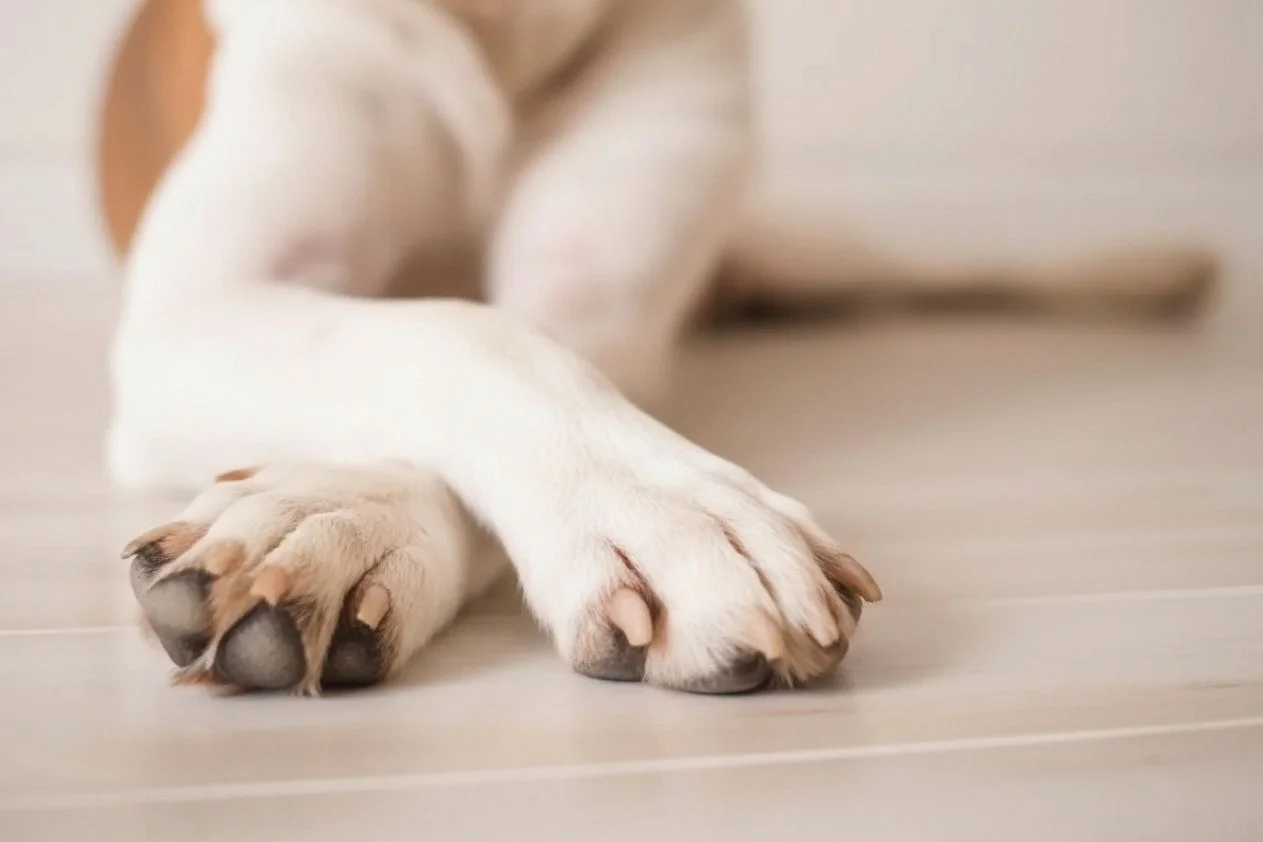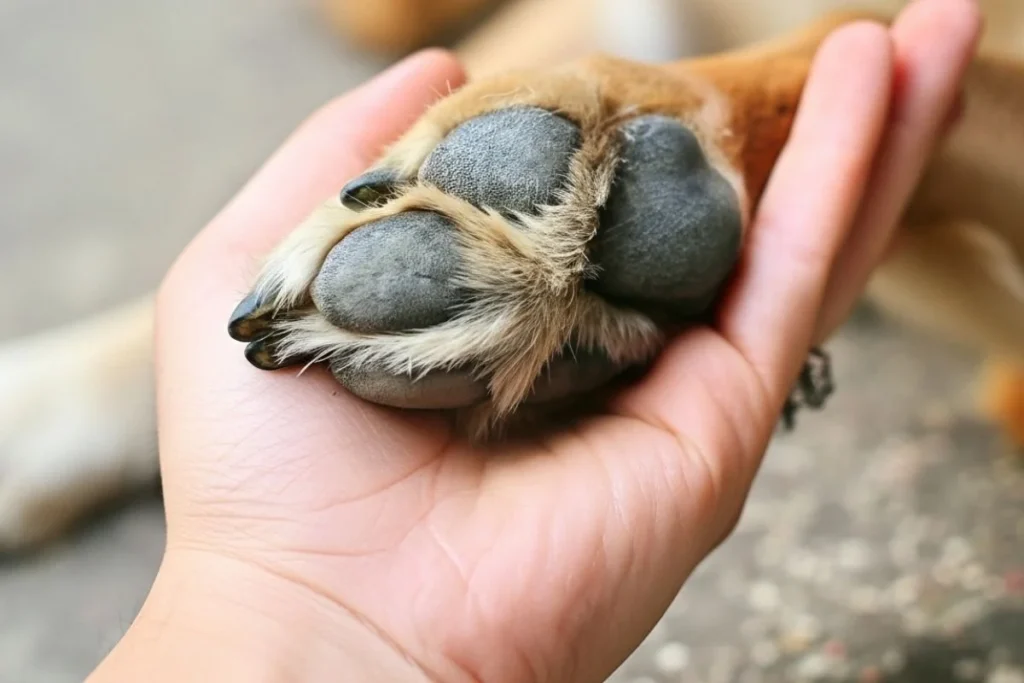

Looking to prevent dog paw allergies naturally? With 30-40% of dogs experiencing itching and paw allergies being increasingly common, watching your dog constantly lick or chew red, paw pad irritation is heartbreaking. Allergic skin diseases account for 16% of canine skin health cases.
This guide reveals seven proven natural pet remedies using ingredients you likely have at home to prevent and treat paw allergies without harsh chemicals. You’ll utilize a diverse toolkit of natural approaches to keep your dog’s paws healthy and comfortable year-round.
Before diving into natural dog allergy treatments, it’s useful to understand what’s causing your dog’s discomfort.
Dog paw allergies typically stem from three main sources: environmental allergens for dogs, food sensitivities, and contact irritants. Environmental allergens include pollen, mold, dust mites, and grass—things your dog encounters during walks or playtime outside.

Food allergies can also manifest as paw problems. Research shows that:
Recognizing the Symptoms
The most common signs of paw allergies include:
If you notice your dog constantly attending to their paws, it’s time to examine potential allergies.
Conventional treatments (steroids, antihistamines, antibiotics) offer quick relief but have serious drawbacks:
Natural remedies work better because they:
Colloidal oatmeal has been used for centuries to soothe irritated skin, and it is also effective for dogs.
To prepare an oatmeal soak:
The oatmeal creates a protective barrier on the skin while reducing inflammation and washing away allergens. For best results, do this after walks or outdoor play when allergen exposure is highest.
Apple cider vinegar (ACV) has natural antibacterial and antifungal properties that make it effective against yeast, a common secondary infection in allergic paws.
“Apple cider vinegar’s antifungal and antibacterial properties make it a potent natural remedy for yeast infections, causing itchy paws, though it should be diluted 50/50 with water to avoid irritation,” according to pet health experts.

To use ACV safely:
This solution helps restore the skin’s natural pH balance while fighting harmful microorganisms.
Coconut oil is a powerhouse natural remedy with antimicrobial and moisturizing properties.
The medium-chain fatty acids in coconut oil, particularly lauric acid, help fight bacteria and yeast while providing deep moisture to dry, cracked paw pads. It also creates a protective barrier against environmental allergens.
For application:
Many dogs will try to lick off the coconut oil, which is actually safe and can provide internal benefits as well.
Baking soda has natural anti-inflammatory and antiseptic properties that can provide quick relief for itchy paws. Apply only to intact skin, avoiding any open sores.
To create a soothing paste:
This remedy is best used for acute flare-ups rather than daily maintenance. The alkaline nature of baking soda helps neutralize acids that may be irritating your dog’s skin.
Herbal teas offer gentle yet effective relief for inflamed paws through their natural anti-inflammatory compounds.
For a healing herbal soak:
These soaks are especially effective after exposure to potential allergens like grass or pollen.
What your dog eats directly impacts their skin health and immune response to allergens.
According to research, food allergies play a significant role in skin problems, with a 30% increase in atopic dermatitis cases reported in the United States over the last decade. Dietary changes can have a big impact.
Consider these modifications:
Always consult your veterinarian before making significant dietary changes, especially if your dog has existing health conditions.
Creating a physical barrier between your dog’s paws and environmental allergens is one of the most effective preventative measures.
Chemical-free pet products like beeswax-based balm for your pet offer a natural solution made with bee-derived ingredients that form hypoallergenic dog care and a protective shield against allergens, salt, hot pavement, and other irritants.
The beeswax-based formula:
Apply a thin layer before going for a walk or doing outdoor activities, focusing on the pads and between the toes. For severe cases, apply before bedtime and cover with light cotton socks for overnight treatment.

Aside from remedies, long-term management of paw allergies requires prevention.
Establish a regular paw cleaning routine by wiping your dog’s feet with a damp cloth after walks. This simple step removes allergens before they can irritate. For a more thorough cleaning, dip your paws in a shallow pan of plain, warm water.
Make environmental modifications at home by:
Allergy triggers change with the seasons, requiring adjustments to your prevention strategy.
While natural remedies are effective for many dogs, some cases require professional attention. Seek veterinary care if you notice:
A veterinarian can conduct allergy testing to identify specific triggers and rule out other possible causes, such as mites, bacterial infections, or foreign bodies.
For dogs with severe allergies, a combination of natural remedies and targeted medical treatment may provide the best relief. Your vet can help create an integrated approach that minimizes medication while maximizing comfort.
Preventing dog paw allergies naturally requires a multi-faceted approach that addresses both symptoms and underlying causes.
By combining regular paw cleaning, protective measures like Sweet Comb Chicago’s Paw Protection Wax, dietary adjustments, using natural ingredients safe for dog skin, and targeted natural remedies, you can significantly reduce your dog’s discomfort without relying on pharmaceuticals.
Implementing these practices daily will yield better results than occasional treatments during flare-ups. With patience and persistence, you can help your dog enjoy comfortable, itch-free paws year-round.
For severe or persistent cases, work with your veterinarian to develop an integrated plan that combines the best of natural and conventional approaches. Your furry friend deserves nothing less than comprehensive care for those hardworking paws.
Explore Our Natural Pet Care to discover how our bee-derived products can complement your dog’s natural allergy prevention routine.

Founder of Sweet Comb Chicago
